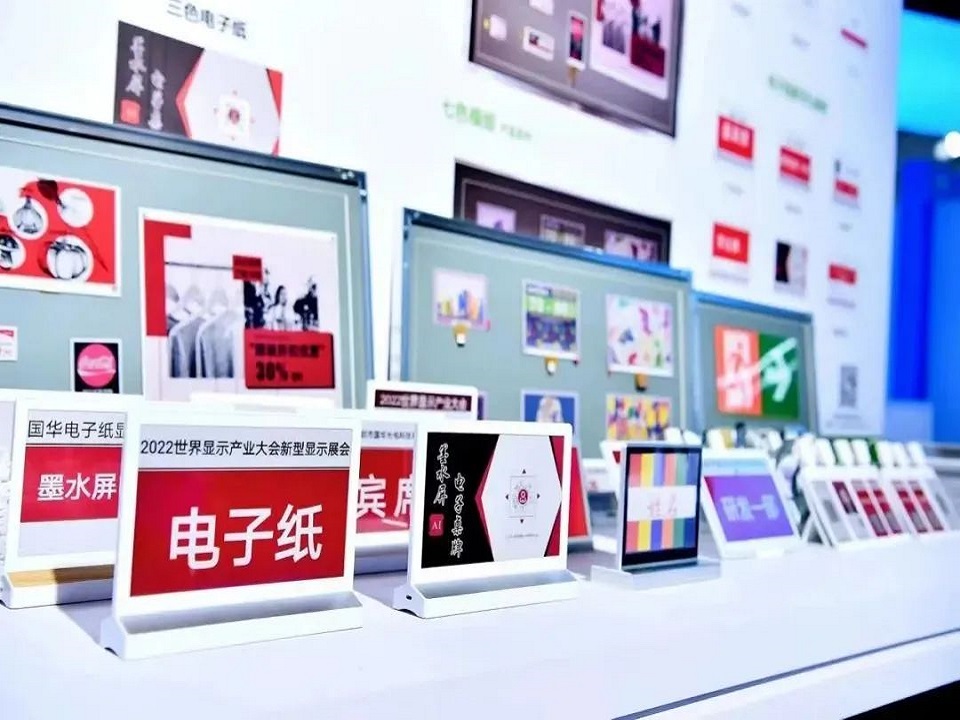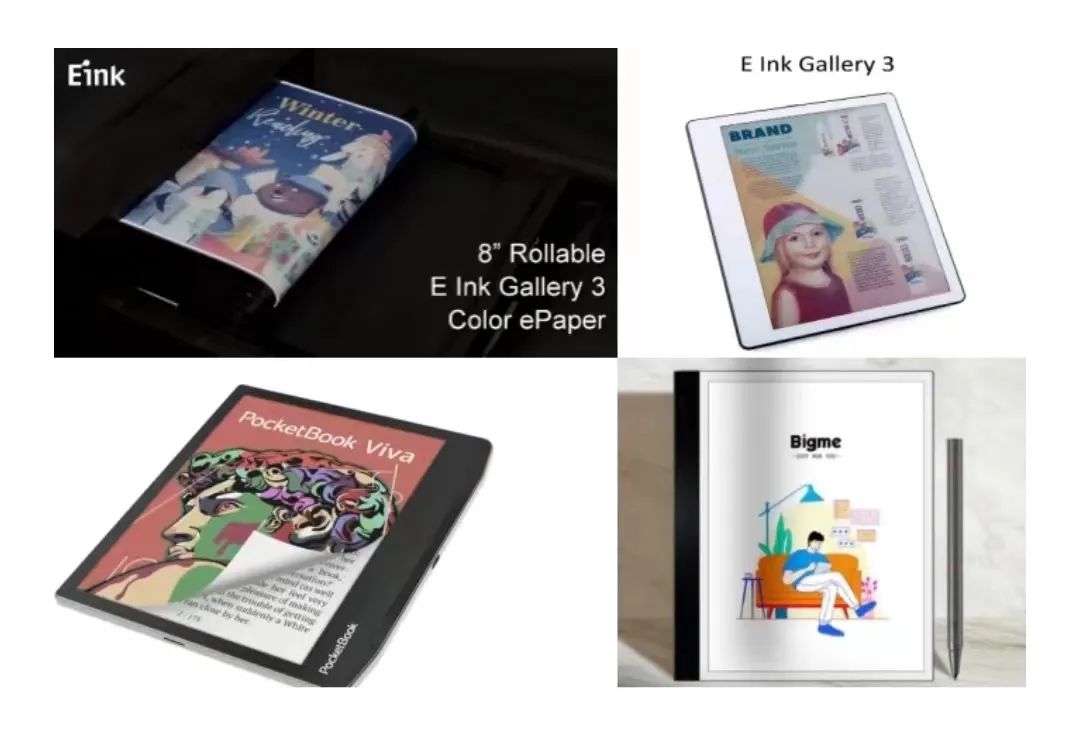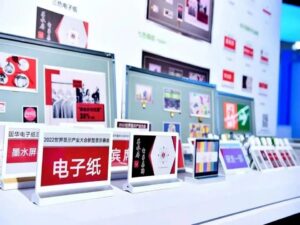With the unique aura of “green and low carbon”, e-paper technology has become a “dark horse” that is rapidly running on the new display track. RUNTO predicts that by 2025, the overall market size of the global e-paper industry will reach US$72.3 billion, with a compound annual growth rate of 68.9%.
At present, in the fertile soil of electronic paper, there is a technical competition between the three main technical routes of electrophoretic display (EPD), electrowetting and cholesteric liquid crystal (ChLCD): who will win the technical competition, And seize the opportunity when the industry explodes? This will become the most anticipated suspense in this 100 billion yuan market in the future.

In the field of display, electronic paper (“electronic ink screen”) is a special display screen. Compared with other types of ordinary display screens, it has distinct advantages such as ultra-light and ultra-thin, close to zero power consumption, and green eye protection. The reason for these advantages is due to the “bistable and reflective” display characteristics of electronic paper technology: electronic paper only consumes a small amount of power when changing the screen, and continues to display without disappearing after power supply is stopped; It needs a backlight, relies on ambient light to reflect text and images into the human eye, and has a paper-like display effect. With the blessing of these auras, e-paper is recognized as one of the excellent solutions under the global “double carbon” goal. The attention or layout of well-known enterprises.
From a technical point of view, a variety of subdivision technologies have emerged in the more than 50 years since the start of electronic paper research and development, but at present, the three technical routes of electrophoresis, electrowetting, and cholesteric liquid crystals have become the three most concerned categories in the industry.
At present, the e-paper stock market is mainly based on electrophoresis technology, focusing on near-zero power consumption, low response, bistable price tags, quasi-static e-books, bus stop signs and other application requirements, showing a trend of vigorous development, and the penetration rate is still low. There is considerable room for improvement. It is worth mentioning that Yuantai Technology E Ink, which takes the electrophoretic display route, is currently the only e-paper manufacturer that has achieved mass production and has an annual output of millions of pieces, with a global market share of more than 90%. For more than ten years, E Ink has invested a lot of energy in developing an ecosystem from materials (EPD film and technology) to overall solutions (e-reader display panels and ESL modules), and its industry competitiveness is more reflected in its comprehensive strength.
With the advantages of “color and video” and the property of paper-like health and eye protection, electrowetting electronic paper will not only cover part of the electrophoretic market, but also cultivate the incremental market of electronic paper, focusing on the dynamic color reflective display with strong interactive needs application market.
However, variables appear in cholesteric liquid crystal e-paper. In February this year, Fudong Technology, together with Chenhong TPK-KY, Iridescent Optoelectronics, Nanjing Panda Electronics, and Yunchuang Communications, held a product launch conference for cholesteric liquid crystal color electronic paper, displaying multi-size cholesteric liquid crystal color electronic paper display products. Fudong Technology pointed out that the exhibited products have generally adopted color electronic paper technology, and are widely used in commercial applications such as publishing, education and retail distribution. In the future, it can be expanded to industrial control, industrial computers or medical field assistance application.
The reporter learned that cholesteric liquid crystal electronic paper first appeared in 2000. Due to the limitation of the reflection band, the first cholesteric liquid crystal electronic paper was in yellow-green mode. It has been a hot spot in the field of liquid crystal display for several years.
So, from the perspective of the “three-way” e-paper technology track, who has more development potential?
The reporter learned through interviews with industry experts that compared with the three electronic paper display technologies of cholesteric liquid crystal, electrophoresis, and electrowetting, both cholesteric liquid crystal and electrophoresis have bistable characteristics, but the response speed is slow, and smooth video display cannot be achieved at present. , but electrowetting has a faster response speed and is compatible with the current mainstream 50FPS video playback. In terms of colorization, both cholesteric liquid crystal and electrowetting can use the method of vertical color mixing to achieve a better display color gamut, but the current colorization of electrophoresis mainly relies on filters, which cannot take into account both brightness and display color gamut, so the color display effect At present, it is still unsatisfactory, and the electrophoretic display using four-color particles can improve the color effect to a certain extent, but it will affect the response speed. In terms of energy consumption, electrophoresis has the lowest energy consumption, followed by cholesteric liquid crystal, and electrowetting has slightly higher energy consumption because it does not have a bistable state.
Zhou Guofu, a distinguished professor of South China Normal University and chairman of Shenzhen Guohua Optoelectronics Technology Co., Ltd., told the reporter of “China Electronics News” that the characteristics of electrophoretic electronic paper are the lowest energy consumption and the black and white display effect closest to paper. The paper is characterized by the response speed of playing video and better colorization effect, while the cholesteric liquid crystal electronic paper is expected to achieve the response speed of playing video, but it has certain limitations in terms of color and viewing angle.
It is not difficult to find that each of the above three e-paper technology routes has its own characteristics and advantages, and the specific application fields need to be explored and explored by different manufacturers themselves. Zhang Ning, director of electronic paper research at Luotu Technology, told the reporter of “China Electronics News” that the simultaneous existence of multi-technology circuits has a significant positive effect on the technological development of the electronic paper industry. Compete with each other and learn from each other’s strengths. In the end, 1 or 2 technologies stand out.

After more than 20 years of development, the e-paper display industry has formed a market scale with annual sales of more than 10 billion US dollars. With the demand for eye-protection display terminals in mainstream display markets such as the Internet of Things and smart cities, e-paper is ushering in explosive growth. According to data from Luotu Technology, global e-paper module shipments will reach 260 million pieces in 2022, a year-on-year increase of 23%. It is estimated that in 2023, the overall market size of the global e-paper industry will reach US$36 billion, a year-on-year increase of 140%; by 2025, the scale will reach US$72.3 billion, with a compound annual growth rate of 68.9%.
Faced with a huge market space, the industry is increasing research and development and investment in electronic paper, and with the development of technology, the competition among different routes will become more intense. Xie Zhongli, senior research manager at Omdia, pointed out that in many display panel applications that require bistable characteristics of energy consumption, cholesteric liquid crystal display panels begin to compete with electrophoretic display panels, and response time and color performance may be the former to catch up with the latter Chance.
Li Zhenghao, chairman of Yuantai Technology, pointed out in an exclusive interview with a reporter from “China Electronics News” that Yuantai’s goal is to replace paper, so he is more optimistic about electrophoretic electronic paper technology, hoping that electronic paper can be applied to the surface of any object in the future , and turn it into a digital, non-luminous display product. In the future, when the full-color electronic paper display technology matures, it will be more widely used.
Different from electrophoresis and cholesteric liquid crystal display, the “ambition” of electrowetting technology is to break through the color video display of electronic paper. However, due to its technical difficulty, the progress of industrialization is still relatively slow.
In fact, e-paper technology can be defined as a slow-variable technology track. The development of products with this characteristic will inevitably have a long-term industrial chain running-in process. While various technical routes of electronic paper have existed for a long time, only electrophoretic display has been successfully commercialized on a large scale for a long time.
The reason, Dong Min, deputy secretary-general of the China Electronic Video Industry Association, analyzed to the reporter of “China Electronics News” that this aspect may be the difference in the research and development and commercialization schedule of each technology owner, and more importantly, Perhaps the e-paper market in the past was only a niche market, and the market size and prospects of the year limited resource investment. “The replacement or competition of new display technology depends not only on its index performance, but also on reliability, yield, cost and the development of the industry camp.” Dong Min emphasized to reporters.
“Various e-paper display technologies have their own characteristics, and no one technology can perfectly meet all market needs. Therefore, the future e-paper market must have a variety of technical paths.” Zhou Guofu believes that in electronic labels, In fields such as electronic billboards, the bistable electronic paper technology route will still be the mainstream; in the fields of smart display terminals, outdoor advertising screens, etc., the electronic paper technology route with video response speed will become the mainstream; while in the wearable electronics market, Flexible electronic paper is required. Zhang Ning added that compared with other electronic products, the development of the electronic paper industry is still in the early stage of rapid growth. Various technologies compete with each other, which can fully release the development capabilities of product terminals and realize the innovative development of the industry.
Many experts interviewed by the reporter believe that the future direction of electronic paper products is large-scale, colorful, flexible and video-oriented.
Generally speaking, color and video compatibility is an important threshold for e-paper display to enter the mainstream display market, and it is also an important issue that has been focused on in the field of e-paper display in recent years. Zhou Guofu pointed out that in the future, the electronic paper display technology that can realize color video display will have more room for development, and may become the mainstream electronic paper display technology; although the traditional stable electronic paper cannot realize high-quality color video display, it cannot be used. However, its ultra-low power consumption and paper-like viewing experience are still popular in many application fields and will continue to occupy a place.



